Rapid and Nondestructive Classification of Cantonese Sausage Degree Using Hyperspectral Images
Abstract
Featured Application
Abstract
1. Introduction
2. Materials and Methods
2.1. Sausage Sample
2.2. Hyperspectral Imaging System
2.3. Hyperspectral Image Acquisition
2.4. Image Preprocessing
2.4.1. Image Repartition
2.4.2. PLSR Modeling Method
2.4.3. SPA-MLR Modeling Method
3. Results
3.1. Spectral Characteristics of Sausage
3.2. Prediction of Sausage Degree using All Wavelengths
3.2.1. Noise Band Removal
3.2.2. Modeling Results of PLSR
3.3. SPA-MLR
3.3.1. Effective Wavelengths Selection
3.3.2. Regression Analysis
4. Discussion
Author Contributions
Funding
Conflicts of Interest
Abbreviations
| SPA | successive projections algorithm |
| PLSR | partial least squares regression |
| NIR | near infrared spectroscopy |
| MLR | multiple linear regression |
| ROI | region of interest |
| RMSE | root mean square error |
| STDEV | standard deviation |
| SPME | solid phase micro extraction process |
| GC-MS | gas chromatography-mass spectrometry |
References
- Feng, L.; Qiao, Y.; Zou, Y.; Huang, M.; Kang, Z.; Zhou, G. Effect of Flavourzyme on proteolysis, antioxidant capacity and sensory attributes of Chinese sausage. Meat Sci. 2014, 98, 34–40. [Google Scholar] [CrossRef] [PubMed]
- Sun, W.; Cui, C.; Zhao, M.; Zhao, Q.; Yang, B. Effects of composition and oxidation of proteins on their solubility, aggregation and proteolytic susceptibility during processing of Cantonese sausage. Food Chem. 2011, 124, 336–341. [Google Scholar] [CrossRef]
- Bai, F.; Guo, S.; Jiang, A.; Wmills, E.; Ncutter, C.; He, X.; Wang, Z.; He, W. Physicochemical properties changes of Chinese Guangdong sausage during drying process and storage. Trans. Chin. Soc. Agric. Eng. 2009. [Google Scholar] [CrossRef]
- Liu, S.Y.; Bai, Z.C.; Li, J.-N. GC-MS Analysis of Volatile Aromatic Substances in Chaenomeles speciosa Fruit. J. Chin. Med. Mater. 2012, 35, 728–733. [Google Scholar]
- Pérez-Palacios, T.; Barroso, M.A.; Ruiz, J.; Antequera, T. A Rapid and Accurate Extraction Procedure for Analysing Free Amino Acids in Meat Samples by GC-MS. Int. J. Anal. Chem. 2015, 2015, 209214. [Google Scholar] [CrossRef] [PubMed]
- Brahmbhatt, V.V.; Nold, C.; Albert, C.J.; Ford, D.A. Quantification of Pentafluorobenzyl Oxime Derivatives of Long Chain Aldehydes by GC–MS Analysis. Lipids 2008, 43, 275–280. [Google Scholar] [CrossRef] [PubMed]
- Mohammed, K.; Gamal, E.; Da-Wen, S.; Paul, A. Non-destructive assessment of instrumental and sensory tenderness of lamb meat using NIR hyperspectral imaging. Food Chem. 2013, 141, 389–396. [Google Scholar]
- Song, Y.; Qiao, N.; Li, C.W.; Wen, T.T.; Liu, F.Y. SPME-GC/MS Analysis of Volatile Components from Air-Dried Sausage during Processing. Adv. Mater. Res. 2013, 781–784, 1614–1618. [Google Scholar] [CrossRef]
- Li, X.; He, Y. Discriminating varieties of tea plant based on Vis/NIR spectral characteristics and using artificial neural networks. Biosyst. Eng. 2008, 99, 313–321. [Google Scholar] [CrossRef]
- Liu, F.; He, Y. Classification of brands of instant noodles using Vis/NIR spectroscopy and chemometrics. Food Res. Int. 2008, 41, 562–567. [Google Scholar] [CrossRef]
- Wu, D.; Feng, S.; He, Y. Infrared Spectroscopy Technique for the Nondestructive Measurement of Fat Content in Milk Powder. J. Dairy Sci. 2007, 90, 3613–3619. [Google Scholar] [CrossRef] [PubMed]
- He, Y.; Li, X.-L. Discriminating Varieties of Waxberry Using Near Infrared Spectra. J. Infrared Millim. Waves 2006, 25, 192–194, 212. [Google Scholar]
- Eimasry, G.; Sun, D.; Paul, A. Near-infrared hyperspectral imaging for predicting colour, pH and tenderness of fresh beef. J. Food Eng. 2012, 110, 127–140. [Google Scholar] [CrossRef]
- Kamruzzaman, M.; Elmasry, G.; Sun, D.W.; Allen, P. Non-destructive prediction and visualization of chemical composition in lamb meat using NIR hyperspectral imaging and multivariate regression. Innov. Food Sci. Emerg. 2012, 16, 218–226. [Google Scholar] [CrossRef]
- Wu, X.Y.; Zhao, G.H.; Zhu, S.P. Study on the application of Near Infrared Spectroscopy in the meat quality evaluation. Sci. Technol. Food Ind. 2014, 35, 371–374. [Google Scholar]
- Gaitán-Jurado, A.J.; Ortiz-Somovilla, V.; España-España, F.; Pérez-Aparicio, J.; Pedro-Sanz, E.J.D. Quantitative analysis of pork dry-cured sausages to quality control by NIR spectroscopy. Meat Sci. 2008, 78, 391–399. [Google Scholar] [CrossRef] [PubMed]
- Liao, Y.T.; Fan, Y.X.; Cheng, F. On-line prediction of fresh pork quality using visible/near-infrared reflectance spectroscopy. Meat Sci. 2010, 86, 901–907. [Google Scholar] [CrossRef] [PubMed]
- Prieto, N.; Andrés, S.; Lavín, P.; Giráldez, F.J.; Mantecón, A.R. Ability of near infrared reflectance spectroscopy (NIRS) to predict chemical composition of beef samples. Meat Sci. 2008, 79, 692–699. [Google Scholar] [CrossRef] [PubMed]
- Ellekjaer, M.R.; Isaksson, T.; Solheim, R. Assessment of Sensory Quality of Meat Sausages Using Near Infrared Spectroscopy. J. Food Sci. 2010, 59, 456–464. [Google Scholar] [CrossRef]
- Siripatrawan, U. Hyperspectral imaging for rapid evaluation and visualization of quality deterioration index of packaged dry-cured sausages. Sens. Actuators B Chem. 2018, 254, 1025–1032. [Google Scholar] [CrossRef]
- Alam, M.S.; Elbakary, M.I.; Aslan, M.S. Object detection in hyperspectral imagery by using K-means clustering algorithm with preprocessing—Art. No. 65740M. Proc. SPIE 2007, 6574. [Google Scholar] [CrossRef]
- Fan, Z.; Bo, D.; Zhang, L.; Zhang, L. Hierarchical feature learning with dropout k-means for hyperspectral image classification. Neurocomputing 2016, 187, 75–82. [Google Scholar]
- Naeini, A.A.; Jamshidzadeh, A.; Saadatseresht, M.; Homayouni, S. An efficient initialization method for k-means clustering of hyperspectral data. Int. Arch. Photogramm. Remote Sens. Spat. Inf. Sci. 2014. [Google Scholar] [CrossRef]
- Wang, J.; Shi, T.; Liu, H.; Wu, G. Successive projections algorithm-based three-band vegetation index for foliar phosphorus estimation. Ecol. Indic. 2016, 67, 12–20. [Google Scholar] [CrossRef]
- Zhang, J.; Rivard, B.; Rogge, D.M. The Successive Projection Algorithm (SPA), an Algorithm with a Spatial Constraint for the Automatic Search of Endmembers in Hyperspectral Data. Sensors 2008, 8, 1321–1342. [Google Scholar] [CrossRef] [PubMed]
- Barbin, D.F.; Elmasry, G.; Sun, D.W.; Allen, P. Non-destructive determination of chemical composition in intact and minced pork using near-infrared hyperspectral imaging. Food Chem. 2013, 138, 1162–1171. [Google Scholar] [CrossRef] [PubMed]
- Azami, H.; Mohammadi, K.; Hassanpour, H. An Improved Signal Segmentation Method using Genetic Algorithm. Int. J. Comput. Appl. 2013, 29, 5–9. [Google Scholar] [CrossRef]
- Gong, A.; Zhu, S.; He, Y.; Zhang, C. Grading of Chinese Cantonese Sausage Using Hyperspectral Imaging Combined with Chemometric Methods. Sensors 2017, 17, 1706. [Google Scholar] [CrossRef] [PubMed]
- Gong, A.P.; Wang, Q.; Shao, Y.N. Study on the Quality Classification of Sausage with Hyperspectral Infrared Band. Spectrosc. Spectr. Anal. 2017. [Google Scholar] [CrossRef]
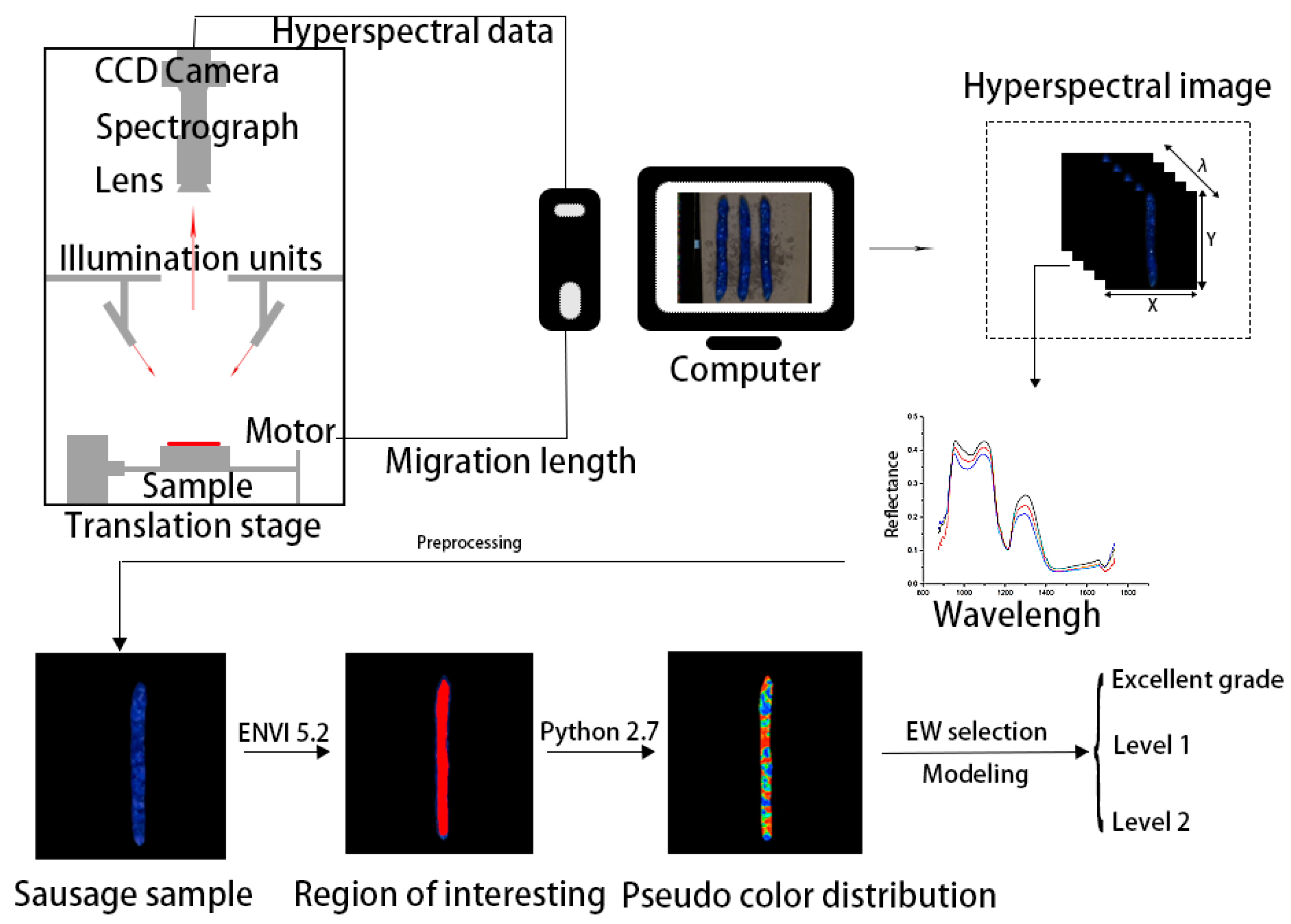
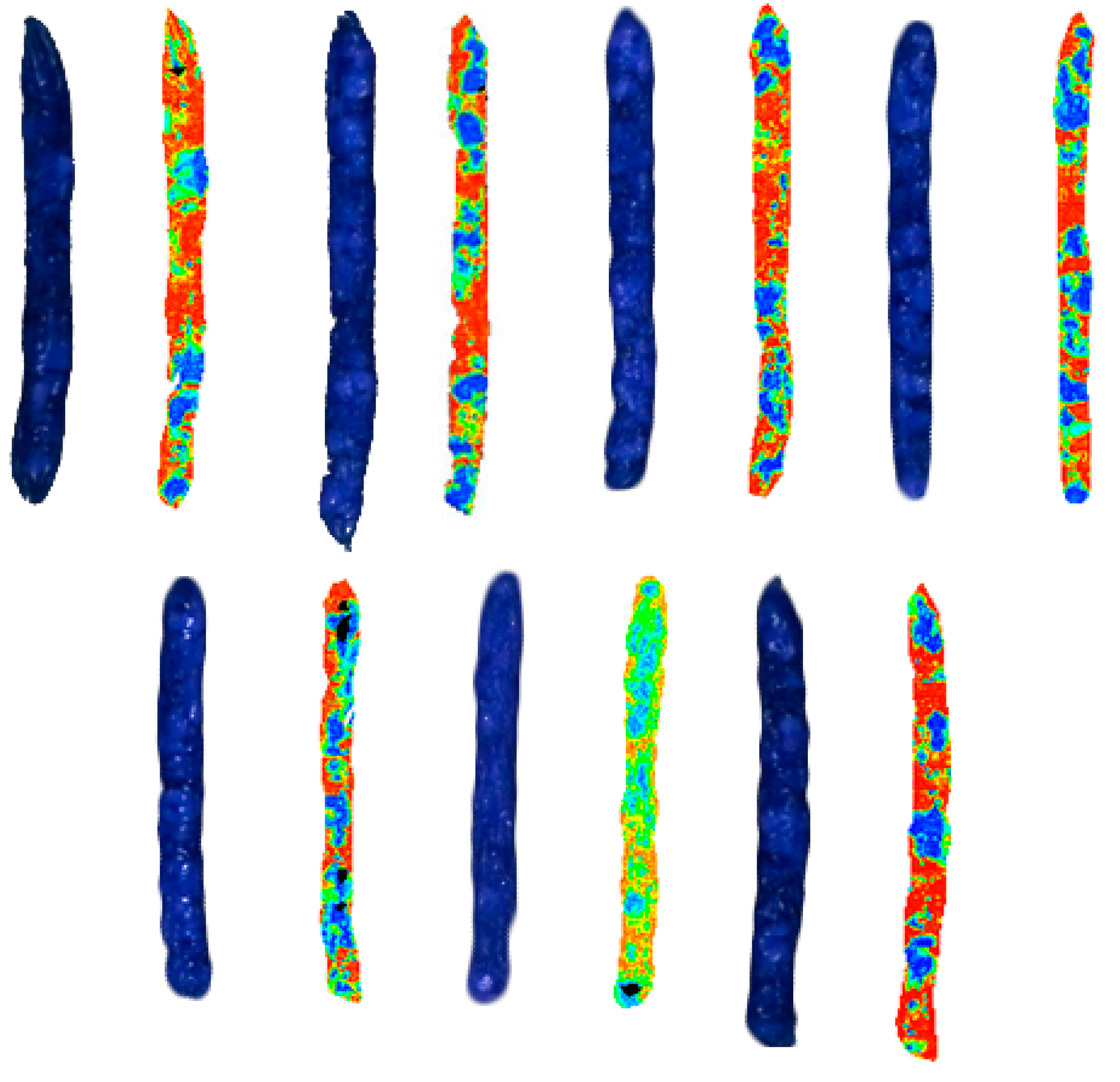
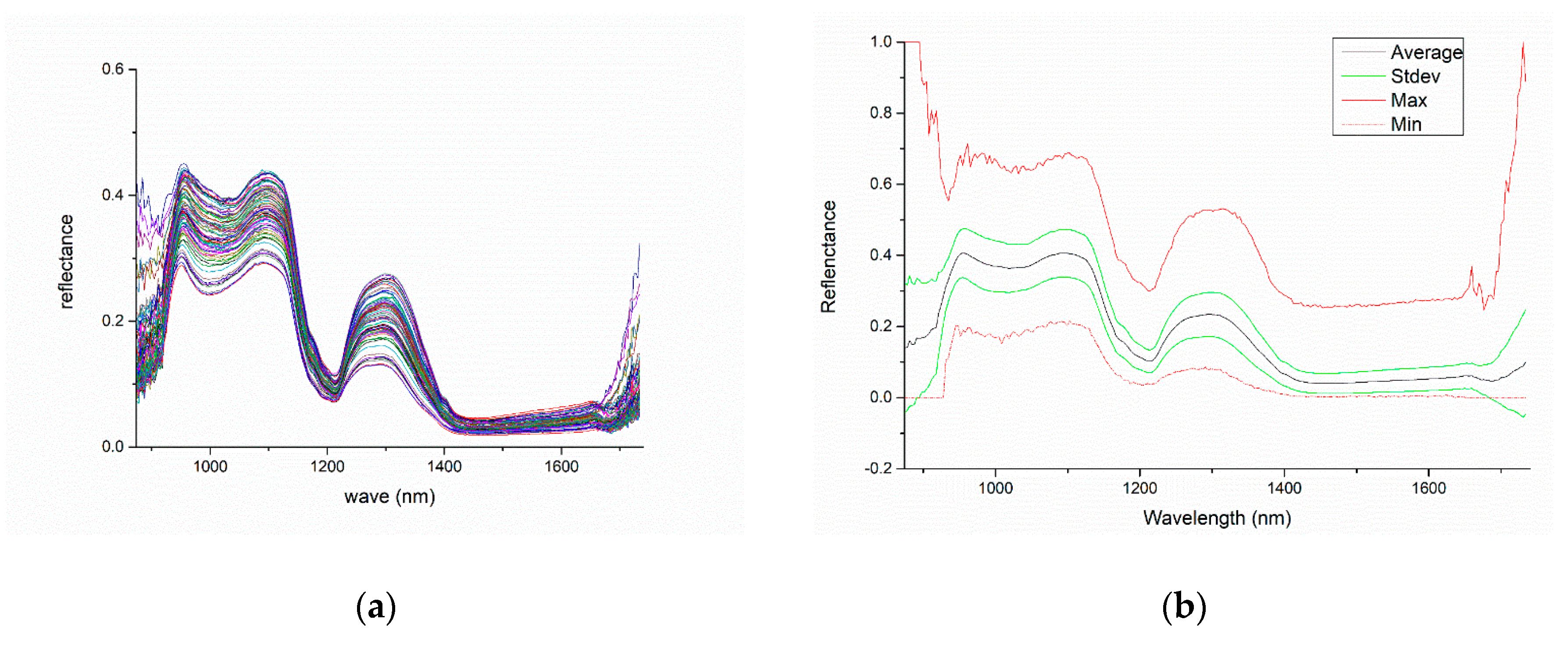
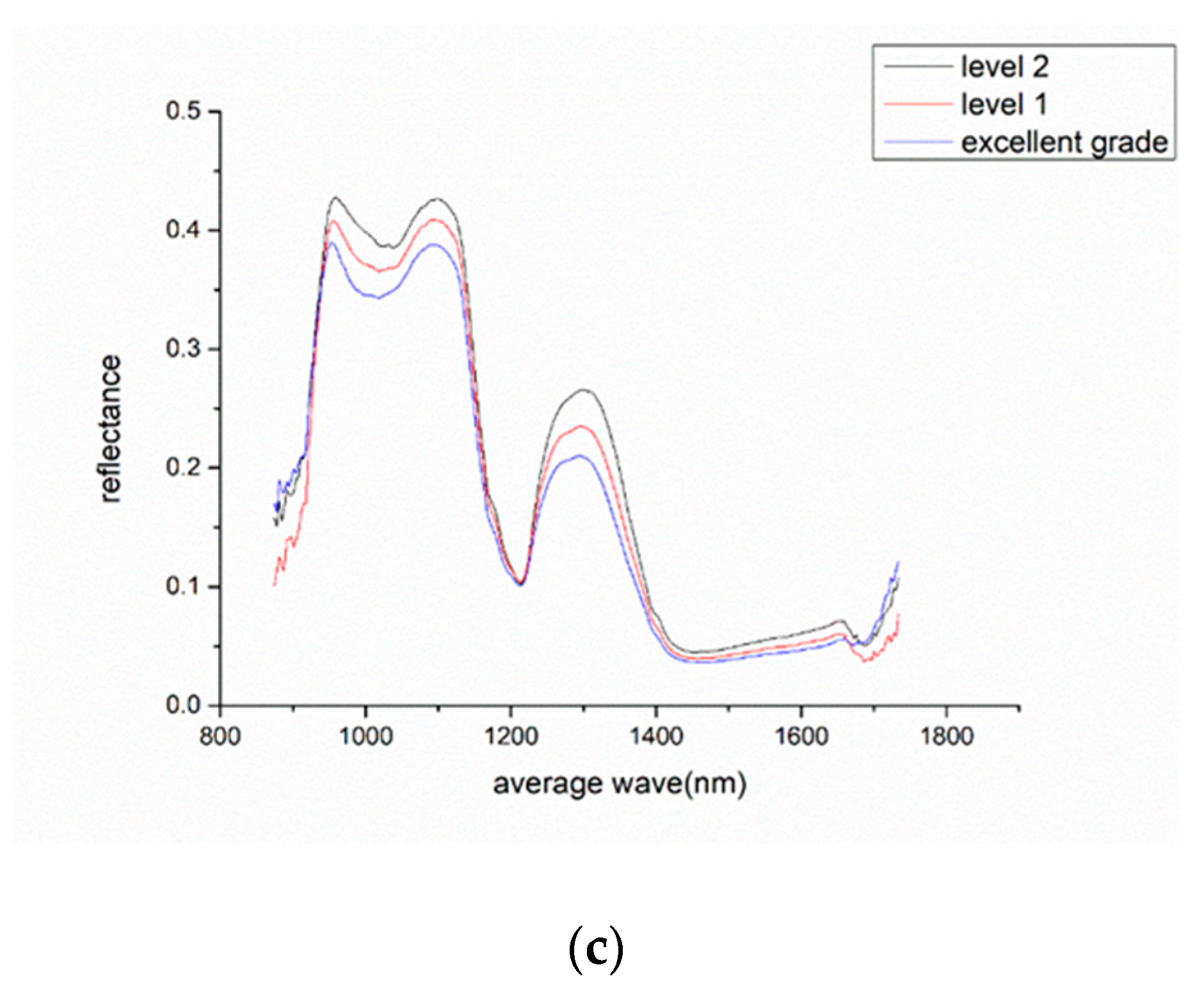
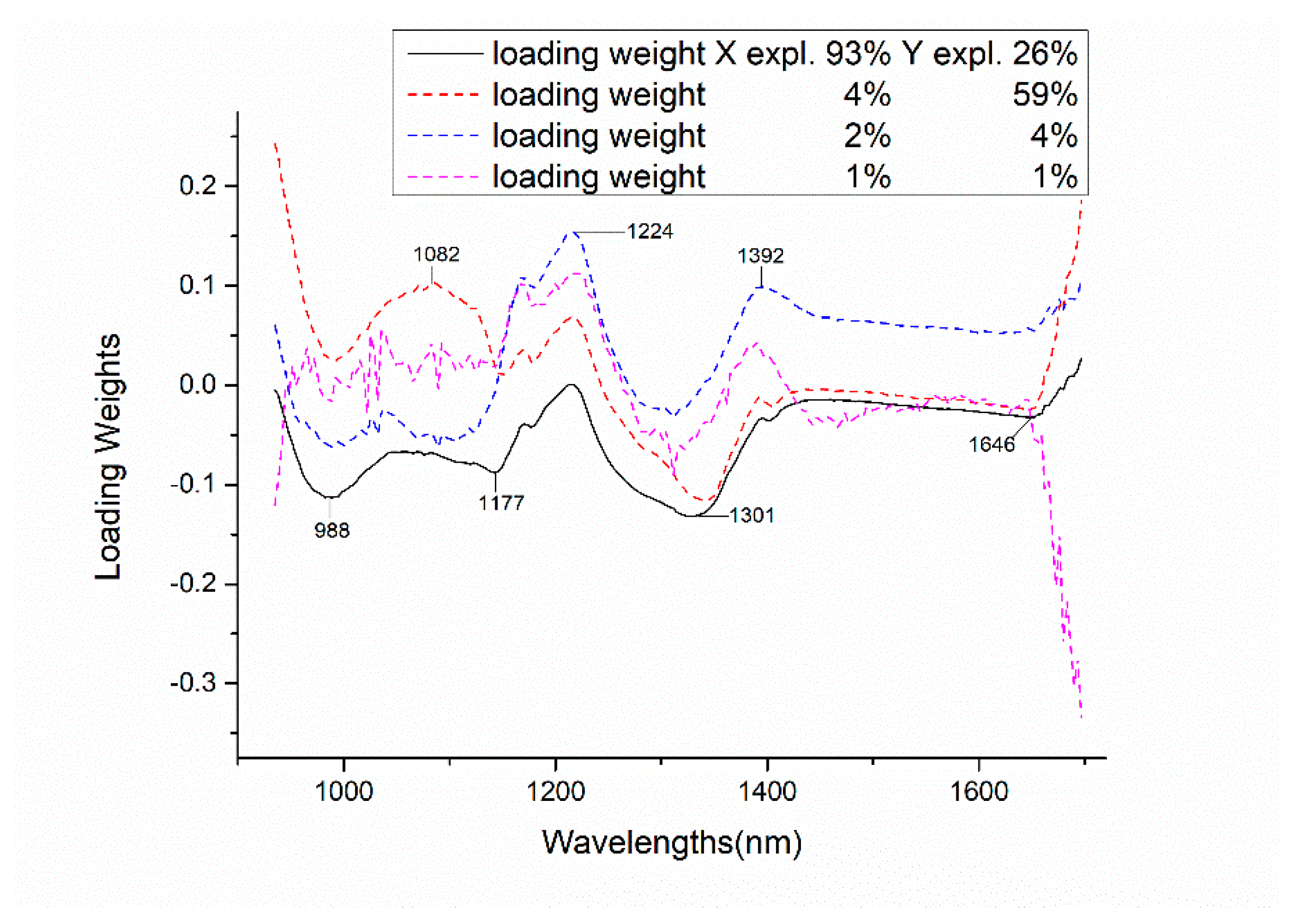
| ROI | Rc2 | RMSEC | RP2 | RMSEP | Dc | DP |
|---|---|---|---|---|---|---|
| All | 0.9890 | 0.0831 | 0.7775 | 0.1828 | 100% | 100% |
| Lean meat | 0.9881 | 0.0865 | 0.6827 | 0.2209 | 100% | 92.31% |
| Fat meat | 0.9875 | 0.0885 | 0.8991 | 0.1996 | 100% | 100% |
| ROI | Rc2 | RMSEC | RP2 | RMSEP | Dc | DP |
|---|---|---|---|---|---|---|
| All | 0.8656 | 0.1635 | 0.8387 | 0.2341 | 100% | 96.15% |
| Lean meat | 0.9371 | 0.1635 | 0.9153 | 0.2422 | 100% | 100% |
| Fat meat | 0.9320 | 0.1686 | 0.8955 | 0.2619 | 98.15% | 96.15% |
© 2019 by the authors. Licensee MDPI, Basel, Switzerland. This article is an open access article distributed under the terms and conditions of the Creative Commons Attribution (CC BY) license (http://creativecommons.org/licenses/by/4.0/).
Share and Cite
Wang, Q.; He, Y. Rapid and Nondestructive Classification of Cantonese Sausage Degree Using Hyperspectral Images. Appl. Sci. 2019, 9, 822. https://doi.org/10.3390/app9050822
Wang Q, He Y. Rapid and Nondestructive Classification of Cantonese Sausage Degree Using Hyperspectral Images. Applied Sciences. 2019; 9(5):822. https://doi.org/10.3390/app9050822
Chicago/Turabian StyleWang, Qi, and Yong He. 2019. "Rapid and Nondestructive Classification of Cantonese Sausage Degree Using Hyperspectral Images" Applied Sciences 9, no. 5: 822. https://doi.org/10.3390/app9050822
APA StyleWang, Q., & He, Y. (2019). Rapid and Nondestructive Classification of Cantonese Sausage Degree Using Hyperspectral Images. Applied Sciences, 9(5), 822. https://doi.org/10.3390/app9050822






